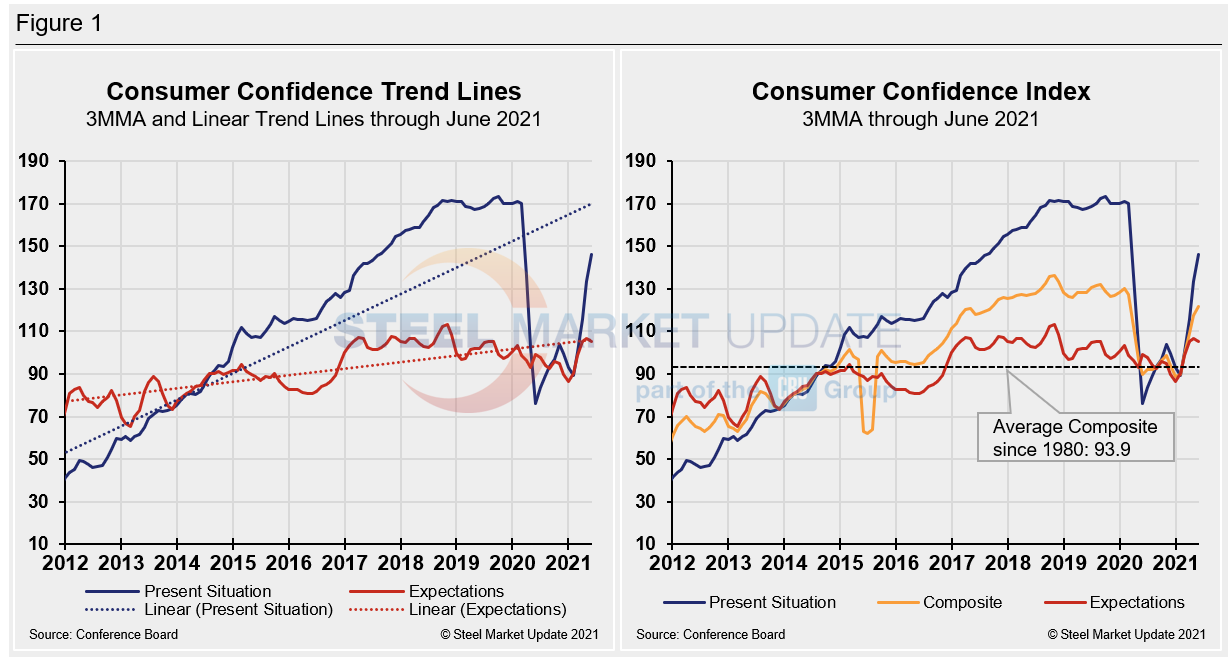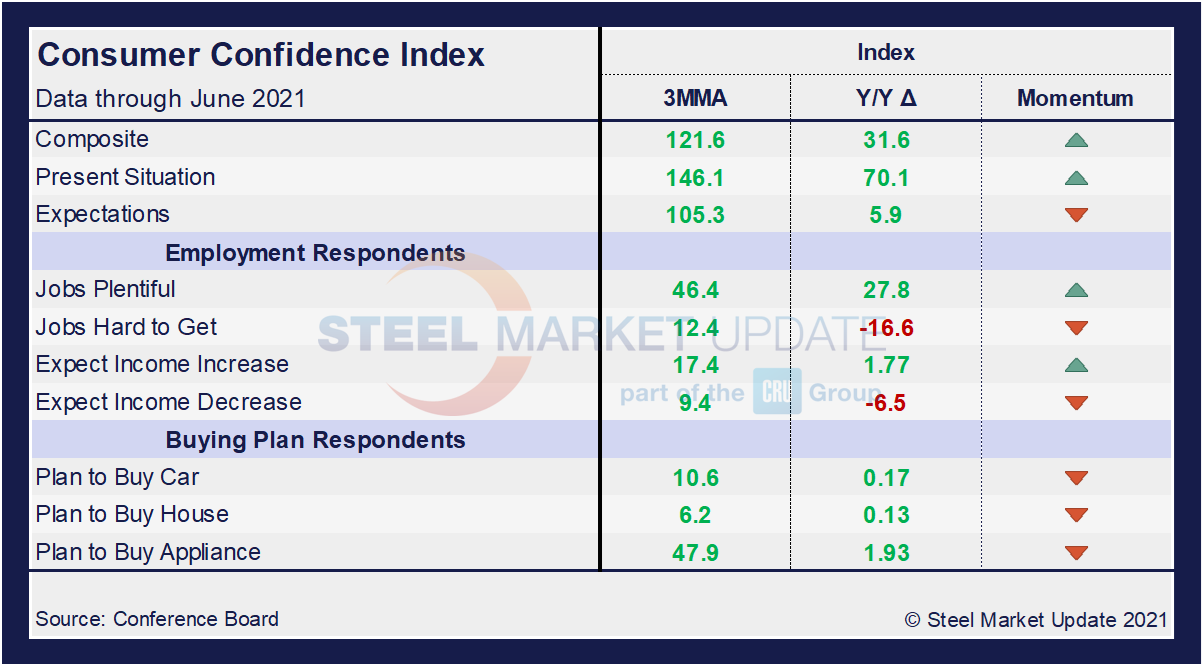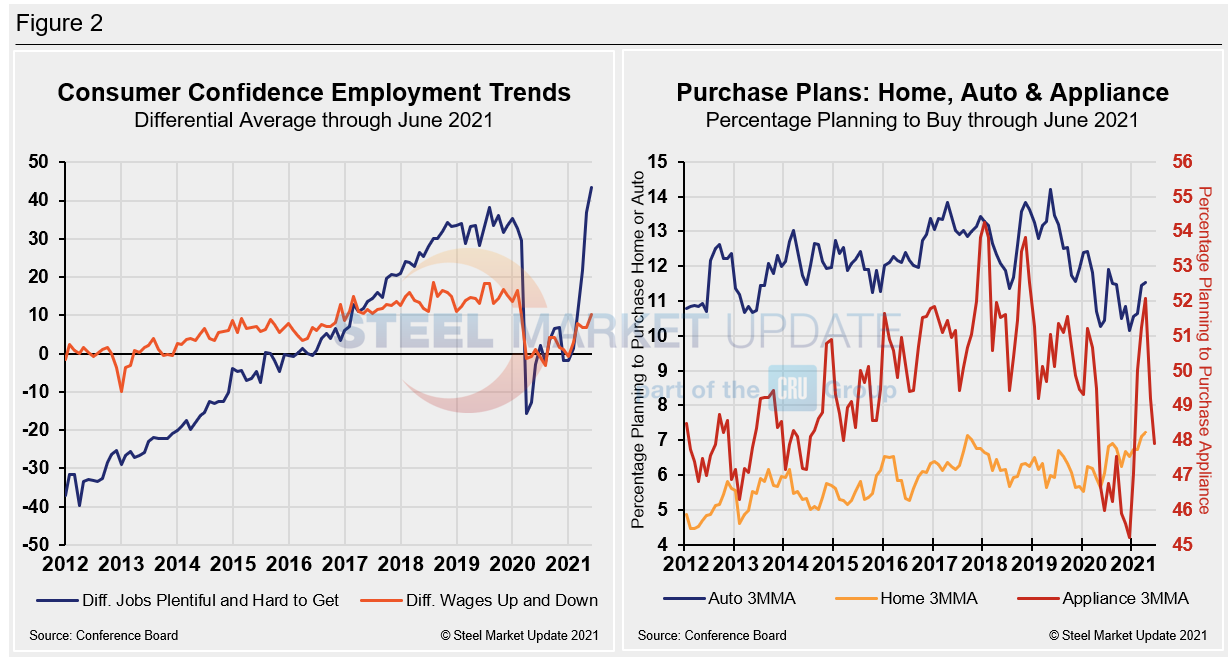Economy

Consumer Confidence: June Data Shows Positive Momentum
Written by David Schollaert
June 30, 2021
U.S. consumer confidence improved further in June on top of repeated gains in each of the four previous months, according to the latest data from The Conference Board. The June index rose by 7.3 points month on month, following increases of nearly 25 points from February through May.
“Consumer confidence increased in June and is currently at its highest level since the onset of the pandemic’s first surge in March 2020,” said Lynn Franco, Senior Director of Economic Indicators at The Conference Board. “Consumers’ assessment of current conditions improved again, suggesting economic growth has strengthened further in Q2. Consumers’ short-term optimism rebounded, buoyed by expectations that business conditions and their own financial prospects will continue improving in the months ahead. While short-term inflation expectations increased, this had little impact on consumers’ confidence or purchasing intentions. In fact, the proportion of consumers planning to purchase homes, automobiles and major appliances all rose—a sign that consumer spending will continue to support economic growth in the short-term. Vacation intentions also rose, reflecting a continued increase in spending on services.”
The Conference Board’s consumer confidence index increase in June is the second largest jump in 2021, following marginal increases in April and May. The index has grown steadily since February, and June’s gains are a positive sign as the marketplace enters the summer months. The recovery was especially significant from February through April, when the consumer confidence index rose from 87.1 to 117.5. A marginal increase in May has been followed by a 6.1% month-on-month increase in June. Despite continued gains, the index is still behind pre-pandemic levels, but advances are likely to continue as the marketplace works towards a full post-pandemic recovery.
The present situation index, which is based on consumers’ assessment of current business and labor market conditions, saw a 9.0 point jump month on month, while the expectations index, which is based on consumers’ short-term outlook for income, business and the labor market, rose by 6.1 points. The present situation index climbed from 148.7 to 157.7 month on month, while the expectations index edged up from 100.9 the prior month to 107.0 in June. The increases, on a percentage basis, were nearly identical to the composite’s gains month on month.
Calculated as a three-month moving average (3MMA) to smooth out the volatility, The Conference Board’s composite index rose in June to 121.6 compared to 117.5 in May—still well below the pre-pandemic high of 130.4 last February, but well above the 90.0 seen one year ago. The composite index is made up of two sub-indexes: the consumer’s view of the present situation and his or her expectations for the future. Figure 1 below notes the 3MMA linear trend lines from January 2012 through June 2021 versus the trend lines of all three subcomponents of the index: present situation, composite and future expectations. All three had edged above the average composite line in October 2020 before falling consecutively through February. The surge from March through June has pulled all three indexes above the composite line once again, with present situation and composite still trending up.

On a 3MMA basis comparing June 2021 with June 2020 in the table below, the present situation is up by 70.1 points, a major leap from just last month when the index was up 30.6 points. Expectations are now a positive 5.9, down from 14.0 the month prior, but that is largely due to the contraction seen the previous month. These increases are notable across all three indexes as our economy and marketplace recover from the COVID-19 blows. When comparing current 3MMA totals to the 2019 pre-pandemic year, however, the composite is still down 6.7 points while the present situation is down 34.2 points. Only expectations are showing a small increase of 4.9 points over that same period. This is further indication the recovery still has ground to make up. The consumer confidence report also includes both employment data and some purchase plans and these are likewise summarized in the table below. The color codes show improvement or deterioration of the individual components.
The composite, present situation and expectations are not only trending up, but have recovered much of what was lost over the past 12 months that resulted from the fallout from the global pandemic. Buying plans for autos, homes and appliances are also up both on a 3MMA basis as well as when compared to year-ago levels; however, the momentum has turned as month-on-month buying plans have slowed. The labor market landscape also has shifted as job openings continue to rise. One recent change has been the optimism respondents have when it comes to the prospect of increased wages, as sentiment has turned from the more tempered view just a month ago.

The differential between those finding jobs plentiful and those having difficulty has swung to a positive 43.5 in June, up from 34.6 in May, easily eclipsing the most recent pre-pandemic high of a positive 35.3 in January 2020. At the height of the COVID-19 health crisis, the differential saw a 51-point swing to a negative 15.7 from January 2020 to April 2020. Since then, the economy has steadily recovered and the differential has rebounded, reaching its highest mark yet. Expectations for future wage changes were similarly affected during the height of the pandemic, but not nearly as much. In January 2020, the differential was positive 13.6, falling to negative 3.0 at its lowest in August, but rebounding to a positive 7.9 in March 2021. Since, however, the differential has edged down month on month to a positive 6.9 through May before recovering to a positive 10.1 in June.
The spending plans for consumer goods as measured by automobiles, homes and appliances had been trending up and following the growth in consumer confidence. May, however, saw the first dip across all three major categories. The dip was short-lived as June numbers rebounded and buyers grow increasingly assured of the market’s return to health. The high point came in March when home buying plans reached the 7.5-point mark, while spending for automobiles and appliances also reached their recent highs in the same period. All three indices then proceeded to edged down consecutively, but June’s report posted a turnaround for all three. These dynamics are illustrated below in Figure 2.

SMU Comment: The return to growth across the three main indexes, employment dynamics and buying plans are a pleasant sight as the summer is in full swing. An improving job market and fiscal stability should drive market growth and consumer confidence in the coming months.
About The Conference Board: The Conference Board is a global, independent business membership and research association working in the public interest. The monthly Consumer Confidence Survey®, based on a probability-design random sample, is conducted for The Conference Board by Nielsen. The index is based on 1985 = 100. The composite value of consumer confidence combines the view of the present situation and of expectations for the next six months.
By David Schollaert, David@SteelMarketUpdate.com

David Schollaert
Read more from David SchollaertLatest in Economy

Chicago PMI dips 0.1 points in June
The Chicago Purchasing Managers Index (PMI) slipped 0.1 points to 40.4 points, in June.

Multi-family pullback drives housing starts to 5-year low in May
US housing starts tumbled in May to a five-year low, according to figures recently released by the US Census Bureau.

Architecture firms still struggling, ABI data shows
Architecture firms reported a modest improvement in billings through May, yet business conditions remained soft, according to the latest Architecture Billings Index (ABI) release from the American Institute of Architects (AIA) and Deltek.

Manufacturing in New York state contracts again
However, companies are growing more optimistic about the future.

ArcelorMittal plans wire-drawing closure in Hamilton, shifts production to Montreal
ArcelorMittal’s (AM) Hamilton location to be shuttered, wire production shifting to Montreal.
